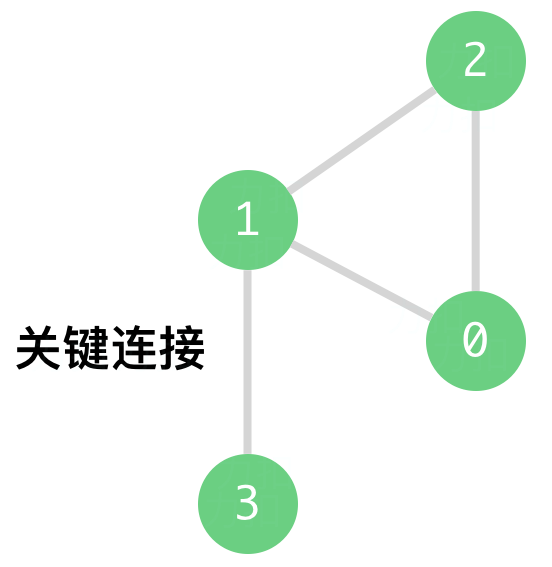C++
Java
Python
Python3
C
C#
JavaScript
Ruby
Swift
Go
Scala
Kotlin
Rust
PHP
TypeScript
Racket
Erlang
Elixir
Dart
monokai
ambiance
chaos
chrome
cloud9_day
cloud9_night
cloud9_night_low_color
clouds
clouds_midnight
cobalt
crimson_editor
dawn
dracula
dreamweaver
eclipse
github
github_dark
gob
gruvbox
gruvbox_dark_hard
gruvbox_light_hard
idle_fingers
iplastic
katzenmilch
kr_theme
kuroir
merbivore
merbivore_soft
mono_industrial
nord_dark
one_dark
pastel_on_dark
solarized_dark
solarized_light
sqlserver
terminal
textmate
tomorrow
tomorrow_night
tomorrow_night_blue
tomorrow_night_bright
tomorrow_night_eighties
twilight
vibrant_ink
xcode
上次编辑到这里,代码来自缓存 点击恢复默认模板
class Solution {
public:
vector<vector<int>> criticalConnections(int n, vector<vector<int>>& connections) {
}
};
运行代码
提交
golang 解法, 执行用时: 356 ms, 内存消耗: 36.2 MB, 提交时间: 2023-10-07 11:22:15
func criticalConnections(n int, connections [][]int) [][]int {
// 建图
m := make(map[int][]int)
for _, c := range connections {
m[c[0]] = append(m[c[0]], c[1])
m[c[1]] = append(m[c[1]], c[0])
}
res := [][]int{}
id := make([]int, n)
for i := range id {
id[i] = -1
}
// tarjan 思路 不断给节点标记id值(发现的先后顺序), 遇到环就把换上节点统一到小值
var dfs func(node, curId, perv int) int
dfs = func(node, curId, perv int) int {
id[node] = curId
for _, next := range m[node] {
if next == perv {
continue
}
if id[next] == -1 {
id[node] = min(id[node], dfs(next, curId+1, node))
} else {
id[node] = min(id[node], id[next])
}
}
if id[node] == curId && node != 0 {
res = append(res, []int{perv, node})
}
return id[node]
}
dfs(0, 0, -1)
return res
}
func min(a, b int) int {
if a < b {
return a
}
return b
}
cpp 解法, 执行用时: 956 ms, 内存消耗: 240.6 MB, 提交时间: 2023-10-07 11:21:24
class Solution {
public:
void buildMap(const vector<vector<int>>& connections, unordered_map<int, unordered_set<int>>& hm){
for(auto& connection: connections){
int nodeA = connection[0];
int nodeB = connection[1];
hm[nodeA].emplace(nodeB);
hm[nodeB].emplace(nodeA);
}
}
int dfs(int node, int nodeID, int parent, vector<int>& id, unordered_map<int, unordered_set<int>>& hm, vector<vector<int>>& ans){
id[node] = nodeID;
for(int neighbor: hm[node]){
if(neighbor == parent) continue;
else if(id[neighbor] == -1){
id[node] = min(id[node], dfs(neighbor, nodeID + 1, node, id, hm, ans));
}else{
id[node] = min(id[node], id[neighbor]);
}
}
if(id[node] == nodeID && node != 0){
ans.push_back({parent, node});
}
return id[node];
}
vector<vector<int>> criticalConnections(int n, vector<vector<int>>& connections) {
unordered_map<int, unordered_set<int>> hm;
vector<int> id(n, -1);
vector<vector<int>> ans;
buildMap(connections, hm);
dfs(0, 0, -1, id, hm, ans);
return ans;
}
};
java 解法, 执行用时: 263 ms, 内存消耗: 145 MB, 提交时间: 2023-10-07 11:21:01
class Solution {
public List<List<Integer>> criticalConnections(int n, List<List<Integer>> connections) {
// 构建一个map,存放每个节点的相邻节点有哪些
Map<Integer, Set<Integer>> map = new HashMap<>();
buildMap(connections, map);
// 创建一个数组,存放每个节点的id是什么
int[] id = new int[n];
Arrays.fill(id, -1);
// 选取一个点作为根节点,dfs向下递归,过程中识别出哪个边是critical connection
List<List<Integer>> res = new ArrayList<>();
dfs(0, 0, -1, id, map, res); // 假设根节点有一个编号是-1父节点
return res;
}
public int dfs(int node, int nodeID, int par, int[] id, Map<Integer, Set<Integer>> map, List<List<Integer>> res){
id[node] = nodeID;
Set<Integer> set = map.get(node);
for(Integer neighbor: set){
if(neighbor == par){
continue;
}else if(id[neighbor] == -1){
id[node] = Math.min(id[node], dfs(neighbor, nodeID + 1, node, id, map, res));
}else{
id[node] = Math.min(id[node], id[neighbor]);
}
}
if(id[node] == nodeID && node != 0){
res.add(Arrays.asList(par, node));
}
return id[node];
}
public void buildMap(List<List<Integer>> con, Map<Integer, Set<Integer>> map){
for(List<Integer> edge : con){
int n1 = edge.get(0);
int n2 = edge.get(1);
Set<Integer> n1n = map.getOrDefault(n1, new HashSet<>());
Set<Integer> n2n = map.getOrDefault(n2, new HashSet<>());
n1n.add(n2);
n2n.add(n1);
map.put(n1, n1n);
map.put(n2, n2n);
}
}
}
python3 解法, 执行用时: 588 ms, 内存消耗: 71.2 MB, 提交时间: 2023-10-07 11:20:49
# dfs + tarjan 算法
class Solution:
def criticalConnections(self, n: int, connections: List[List[int]]) -> List[List[int]]:
# 建图
graph = collections.defaultdict(list)
for conn in connections:
graph[conn[0]].append(conn[1])
graph[conn[1]].append(conn[0])
# 建id
ids = [-1] * n
# 建返回
res = []
# 定义深度优先
def dfs(cur_node, cur_id, par):
# 在探索之前,给你个id
ids[cur_node] = cur_id
# 探索相邻节点
for next_node in graph[cur_node]: # 寻找相邻节点
if next_node == par: # 忽略自己
continue
elif ids[next_node] == -1: # 相邻不知道,深度,并取最小
ids[cur_node] = min(dfs(next_node,cur_id+1,cur_node),ids[cur_node])
else: # 相邻有,取最小
ids[cur_node] = min(ids[cur_node],ids[next_node])
# 整理完的最终id == cur_id(上面传进来的)
# 是环的脑袋
# 另外不要忘记 排除特殊
if ids[cur_node] == cur_id and cur_node != 0:
res.append((par,cur_node))
return ids[cur_node]
dfs(0,0,-1)
return res
